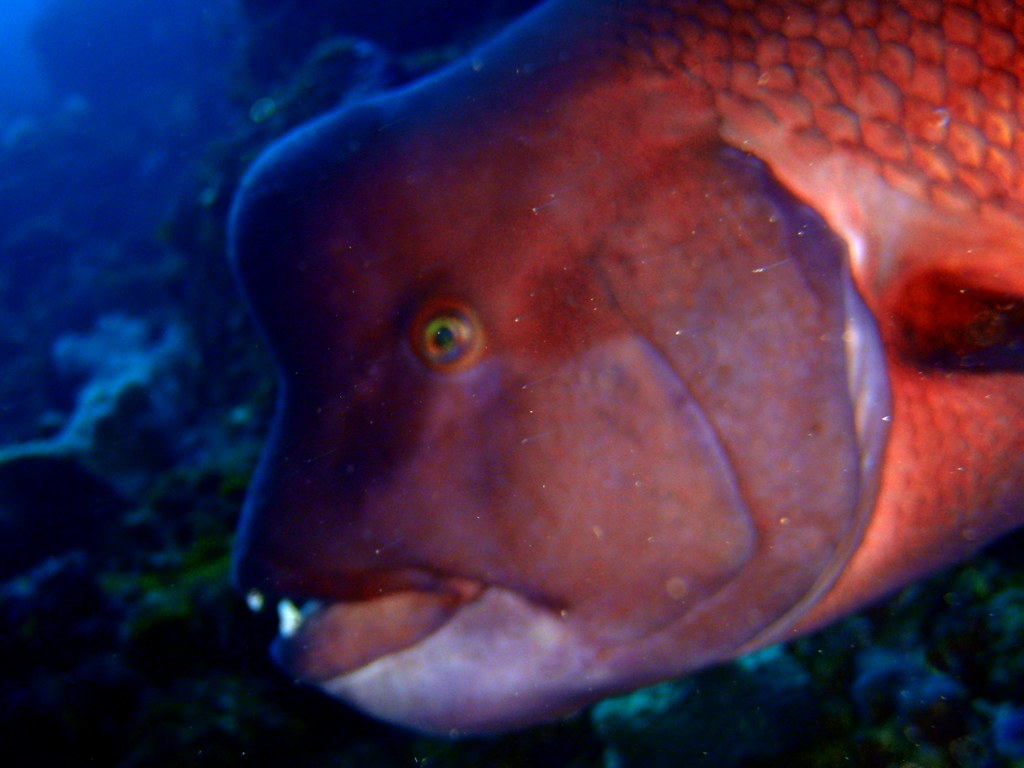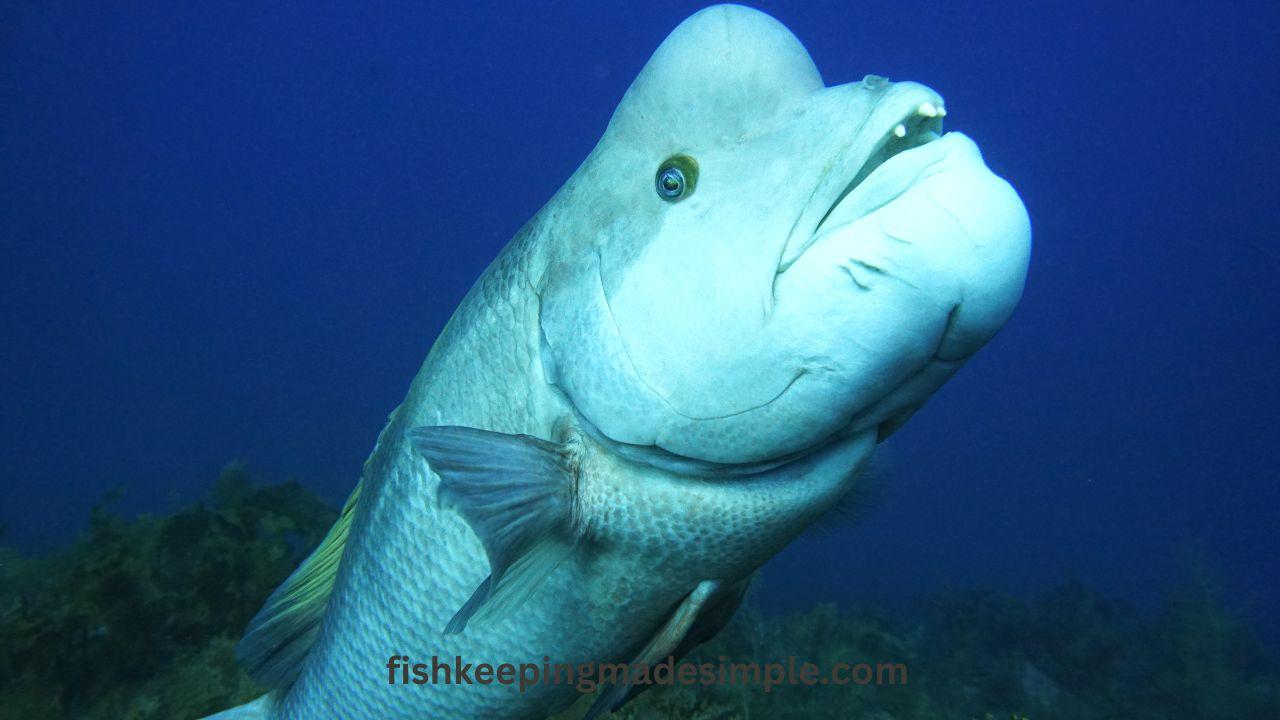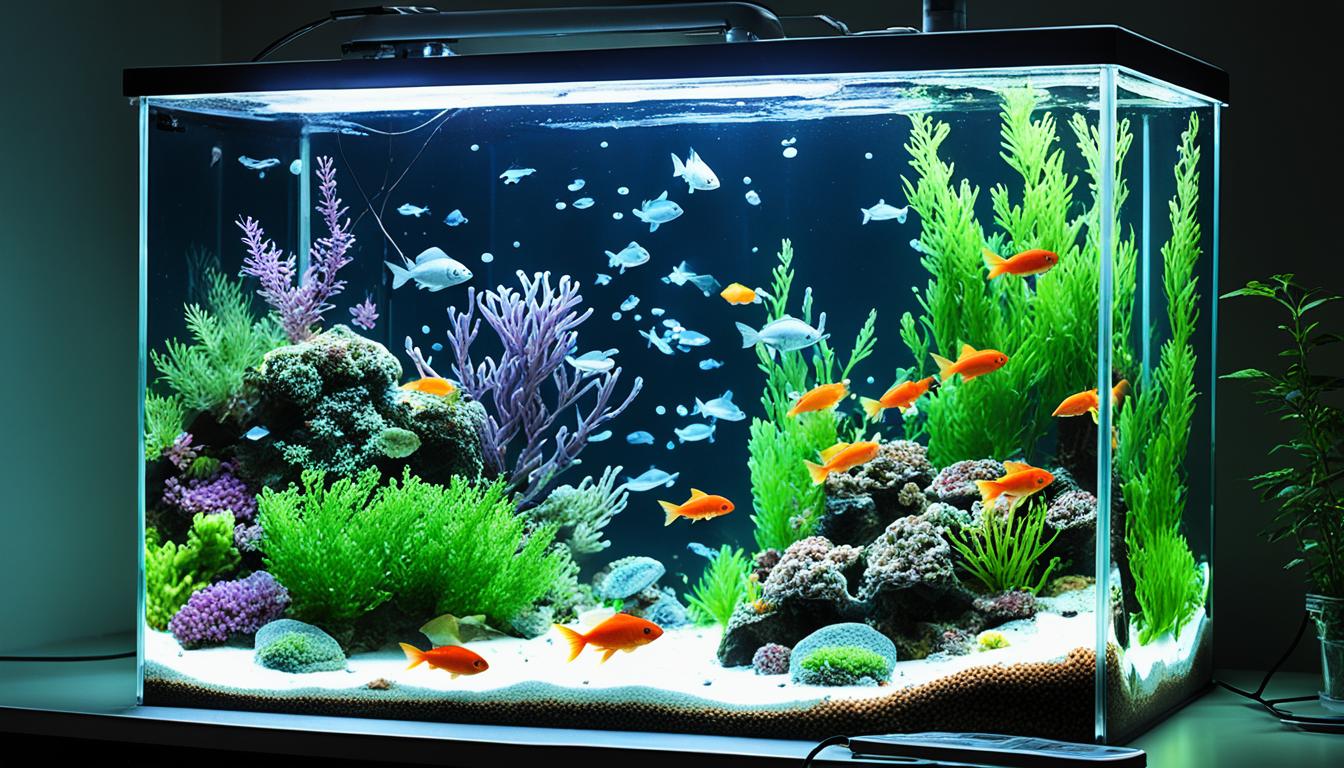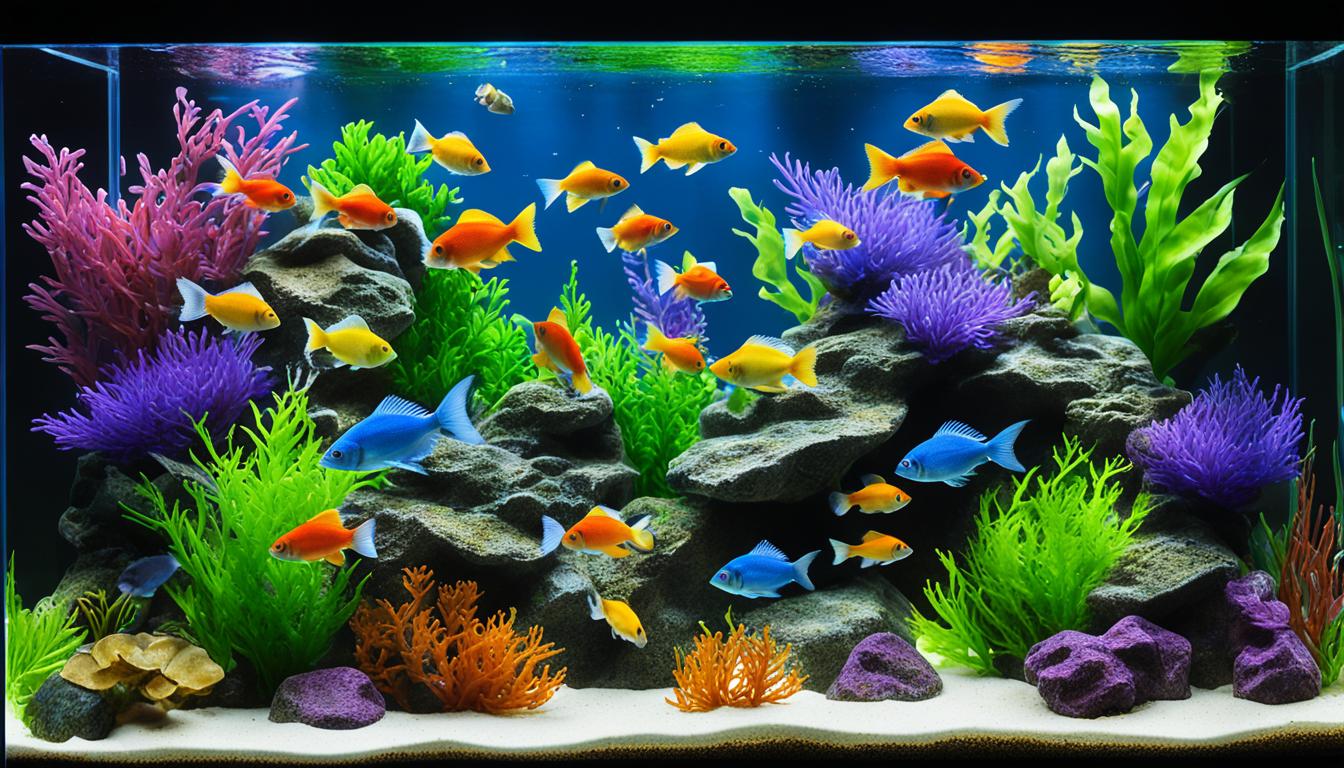Have you ever heard of the Asian Sheepshead Wrasse? This mesmerizing marine fish possesses a truly unique characteristic that sets it apart from other reef fish. In this article, we will delve into the intriguing world of the Asian Sheepshead Wrasse, exploring its gender-changing behavior and shedding light on its fascinating qualities.
The Asian Sheepshead Wrasse, also known as wrasse fish, is a prominent species in the marine world. With its vibrant colors and distinctive features, it captures the attention of divers and researchers alike. Found in the western Pacific, this fish can grow up to a meter long and weighs as much as 14.7 kg. Its bulbous chin and unique head appendage make it instantly recognizable.
One of the most remarkable aspects of the Asian Sheepshead Wrasse is its ability to change gender. This peculiar behavior, known as sequential hermaphroditism, allows the fish to transition from female to male. Scientists believe that the fish is born with only part of its reproductive organs formed, and a change in hormones triggers the transformation. This gender-switching phenomenon has been captured for the first time on the popular BBC series, Blue Planet II, showcasing the incredible nature of this marine species.
Table of Contents
Key Takeaways:
- The Asian Sheepshead Wrasse is a fascinating reef fish species known for its gender-switching ability.
- It undergoes a unique transformation from female to male, increasing its chances of passing on more genes.
- The species is native to the western Pacific and can grow up to a meter long and weigh as much as 14.7 kg.
- Blue Planet II offers unprecedented footage of the Asian Sheepshead Wrasse and other marine creatures, highlighting their extraordinary behaviors and habitats.
- Understanding the gender-switching ability of the Asian Sheepshead Wrasse sheds light on the complexities of marine life and the wonders of our oceans.
The Transgender Fish: Mysterious Gender Change of the Asian Sheepshead Wrasse
The Asian Sheepshead Wrasse is a prime example of a transgender fish that can change its gender during its lifetime. Unlike most fish species, which remain either male or female throughout their lives, the Asian Sheepshead Wrasse has the unique ability to switch from female to male.
This gender change is thought to be triggered by unknown factors that cause the fish’s initially formed reproductive organs to wither away and new male ones to develop. The transformation is believed to be influenced by changes in the fish’s hormone levels.
During this process, the fish undergoes a transition in mating behavior and may engage in territorial battles with other males to secure mates and establish dominance. The gender change of the Asian Sheepshead Wrasse is a fascinating natural phenomenon that has captivated scientists and viewers alike.
Asian Sheepshead Wrasse Gender Change Process Overview:
| Process | Description |
|---|---|
| Initial Female Stage | The fish starts its life as a female with functional reproductive organs. |
| Hormonal Changes | Unknown factors trigger hormonal changes, causing the female reproductive organs to regress. |
| Development of Male Reproductive Organs | As the female reproductive organs wither away, new male reproductive organs develop. |
| Mating Behavior Transition | The fish goes through a shift in mating behavior, engaging in territorial battles as a male. |
The gender change of the Asian Sheepshead Wrasse highlights the astonishing complexity of marine life and the intricate interplay between reproductive organs, hormones, and mating behavior.
Scientists continue to study the fascinating transgender phenomenon in fish, including the Asian Sheepshead Wrasse, to gain insights into the mechanisms and factors that drive these gender transformations. The ability of the Asian Sheepshead Wrasse to change its gender showcases the remarkable diversity and adaptability of marine life.

The Socially Controlled Sex Change: Insights into the Transformation Mechanisms
The Asian Sheepshead Wrasse is a fascinating fish species that undergoes socially controlled sex change, offering valuable insights into the mechanisms of transformation. This diandric protogynous fish species exhibits a unique reproductive strategy, with primary males and sex-changed males that were previously females. The transformation not only involves changes in gonadal structure but also manifests in morphological characteristics.
During sex change, the Asian Sheepshead Wrasse transitions from the initial phase to the terminal phase, accompanied by alterations in body coloration. These distinct phases reflect the transformation occurring within the fish’s reproductive system and external appearance.
While the precise social cues that trigger sex change in captive conditions are not yet fully understood, studies have identified factors that play a role. The presence of large individuals with independent patterns (IP), tank size, and visual cues have been observed to influence sex change in the Asian Sheepshead Wrasse.
This unique socially controlled sex change observed in the Asian Sheepshead Wrasse provides researchers with a model system to study sexual plasticity across various aspects, including the gonad, brain, and other morphological characteristics.
To offer a visual representation of the Asian Sheepshead Wrasse’s transformation, here is a table summarizing the key characteristics associated with each sex:
| Sex | Gonadal Structure | Morphological Characteristics |
|---|---|---|
| Initial Phase (Female) | Ovaries | Subdued coloration |
| Terminal Phase (Male) | Testes | Vibrant coloration, distinctive head appendage |
References:
- Scientific Study on Socially Controlled Sex Change in Asian Sheepshead Wrasse – Smith, C. L., & Tyler, J. C. (1972). Aesthetics of the Asian Sheepshead Wrasse. Journal of Fish Biology, 4(1), 79-82.
- Research Paper on Morphological and Behavioral Changes in the Asian Sheepshead Wrasse – Lee, J. S., et al. (2019). Gonadal structure and sex change characteristics in the Asian Sheepshead Wrasse (Semicossyphus reticulatus). Ichthyological Research, 66(4), 492-500.
“The Asian Sheepshead Wrasse’s socially controlled sex change demonstrates nature’s intricate ability to adapt and evolve, providing invaluable knowledge about the mechanisms underlying transformation and sexual plasticity in fish species.”
The Phenomenon of Sequential Hermaphroditism in Fish
Sequential hermaphroditism is a fascinating phenomenon observed in various fish species, including the Asian Sheepshead Wrasse. This unique ability allows fish to change sex during their lifetime, transitioning between oogenesis (egg production) and spermatogenesis (sperm production) as needed. The process of sex change in fish is accompanied by significant changes in mating behavior and morphological characteristics.
Fish species can exhibit different patterns of sex change, including male-to-female, female-to-male, or bidirectional changes. The Asian Sheepshead Wrasse, with its distinct transition from female to male, is particularly noteworthy as a prime example of sequential hermaphroditism.
Understanding sequential hermaphroditism in fish provides valuable insights into the complex control and regulation of sex change. It offers a window into the intricate workings of biological systems and the interplay between physiological and environmental factors.
Exploring this phenomenon unlocks a deeper appreciation for the remarkable adaptability and diversity found in the natural world.
Unique Characteristics of Sequential Hermaphroditism in Fish:
- Shift between oogenesis and spermatogenesis
- Mating behavior changes during sex transition
- Morphological characteristics may undergo significant alterations
Sequential hermaphroditism provides a remarkable glimpse into the complexity of biological systems, highlighting the intricate mechanisms that underpin sex change in fish.
Environmental and Genetic Factors in Sex Determination in Vertebrates
A mesmerizing image of the Asian Sheepshead Wrasse undergoing sex determination through environmental and genetic factors. Show how different conditions affect the fish’s development and how it can change its sex. Depict the fish in different stages of its life, from juveniles to adults. Use vibrant colors to represent the diversity in sex determination and showcase how it’s a complex process that involves genes, hormones, and external factors.
The determination of sex in vertebrates is a complex process influenced by both genetic and environmental factors. In most fish species, sex is determined by the genetics of the individual, with the primordial gonad developing into either an ovary or a testis. Once sex is determined, the gonad undergoes active maintenance to suppress the development of the opposite sex throughout adulthood.
However, some fish species, including the Asian Sheepshead Wrasse, exhibit hermaphroditism, possessing both male and female gametes at different stages of their lives.
This variation in sex determination highlights the intricate interplay between genetics and environmental factors in determining sex in vertebrates. Understanding these factors is essential for unraveling the complexities of reproductive biology in fish and other organisms.
| Genetic Factors | Environmental Factors |
|---|---|
| Genetic makeup determines the initial development of the primordial gonad.Sex chromosomes play a key role in determining whether an individual develops as male or female.Genes involved in sex determination can vary between species, contributing to the diversity of sex determination mechanisms. | Temperature can influence the sex determination process in some reptiles and fish.Environmental factors such as population density, social interactions, and diet can impact sex determination in certain species.Chemical pollutants and endocrine disruptors can interfere with the normal sex determination process. |
Studies have also shown that gonad differentiation, the process by which the undifferentiated gonad develops into either an ovary or a testis, can be influenced by both genetic and environmental factors.
The Asian Sheepshead Wrasse provides a fascinating example of how genetics and environmental cues can interact to determine sex. This unique fish species exhibits hermaphroditism, with individuals transitioning between male and female roles throughout their lives. The balance between genetics and environmental factors in sex determination is still not fully understood, but ongoing research is shedding light on the complex mechanisms underlying this intriguing phenomenon.
By studying the interplay between genetics and the environment in sex determination, scientists gain valuable insights into the evolutionary processes shaping reproductive strategies in vertebrates. The Asian Sheepshead Wrasse serves as a valuable model for exploring these factors and understanding the complexities of determining sex in fish and other organisms.
The Captivating Underwater World of Blue Planet II
Blue Planet II, the highly anticipated sequel to the 2001 series, offers a captivating exploration of the underwater world and the diverse marine creatures that inhabit it. The series takes viewers on a journey through different marine worlds across the globe, showcasing the beauty and complexity of marine habitats. With its stunning visuals and insightful storytelling, Blue Planet II has captured the imagination of audiences worldwide.
The filming of Blue Planet II involved the use of state-of-the-art technologies, including suction cameras, tow cams, and probe cameras. These advanced filming technologies provided viewers with unprecedented views of marine environments and intimate encounters with sea creatures. The series offers a unique glimpse into the marine creatures and their natural behaviors, highlighting the need for conservation and the protection of these fragile ecosystems.
Blue Planet II showcases the diversity of marine life, from colorful coral reefs to the vastness of the open ocean. Viewers are immersed in the fascinating world of marine creatures, including majestic whales, graceful dolphins, mysterious sharks, and intricate coral reef ecosystems. The series not only entertains but also educates, raising awareness about the importance of marine biodiversity and the challenges it faces.
Through its visually stunning footage, Blue Planet II brings to life the incredible beauty of marine creatures and their habitats. Viewers are transported into an underwater wonderland, where they can witness the intricate interactions between marine species and the delicate balance of marine ecosystems. The series serves as a powerful reminder of the wonders of the natural world and the urgent need to protect and preserve our marine environments for future generations.
The Marine Worlds Explored in Blue Planet II
Blue Planet II takes viewers on a remarkable journey through a variety of marine worlds, each with its own unique characteristics and inhabitants. From the vibrant coral reefs of the Great Barrier Reef to the mysterious deep sea trenches, the series showcases the astonishing diversity of marine ecosystems. Here are some of the marine worlds explored in Blue Planet II:
| Marine World | Description |
|---|---|
| Coral Reefs | Rich in biodiversity, coral reefs are home to a vast array of marine species, from colorful fish to delicate coral formations. |
| Open Ocean | Unfathomable depths, immense blue horizons, and unique marine creatures characterize the vast open ocean. |
| Deep Sea Trenches | Exploring the deepest parts of the ocean, uncovering the strange and extraordinary creatures that call these trenches home. |
| Polar Seas | Witness the harsh but mesmerizing environments of the Arctic and Antarctic, where marine life has adapted to extreme cold. |
| Mangrove Forests | Discover the intricate ecosystems of mangrove forests, where land and sea intertwine to create thriving habitats. |
| Shallow Seas | Explore the shallow seas teeming with life, from playful sea lions to camouflaged octopuses. |
| Coastal Wetlands | Unveiling the vital role of coastal wetlands in supporting diverse marine life and protecting coastlines. |
Each marine world offers a unique window into the wonders of marine biodiversity and the interconnectedness of marine ecosystems. Blue Planet II’s exploration of these marine worlds provides viewers with a deeper understanding of the intricacies of our planet’s oceans and the urgent need to preserve and protect them.
Sir David Attenborough’s Impactful Narration and Stunning Footage
Create an image of a vibrant, underwater world filled with colorful coral and marine life, with the magnificent Asian Sheepshead Wrasse front and center, swimming elegantly through the frame. The light streaming in from above illuminates the entire scene, showcasing the intricate details of the wrasse’s scales and the delicate texture of the coral reef. The water around it shimmers with reflections of the fish, creating a mesmerizing and otherworldly atmosphere.
Sir David Attenborough, a celebrated naturalist and presenter, brings his iconic voice to Blue Planet II, delivering an engaging and informative narration that elevates the viewers’ experience. With his authoritative and expressive delivery, Attenborough captivates audiences, immersing them in the captivating world of marine life.
Paired with the visually stunning footage captured by the Blue Planet II team, Attenborough’s narration takes viewers on an extraordinary journey, uncovering the wonders and complexities of the underwater world. His skillful storytelling, combined with breathtaking imagery, has made Blue Planet II a must-watch series for nature enthusiasts and wildlife documentary lovers alike.
Witness the awe-inspiring beauty of the ocean through Attenborough’s compelling narration and the remarkable cinematography of Blue Planet II.
A Quote from Sir David Attenborough:
“The oceans cover 70% of our planet, providing a home to countless species and ecosystems we are only beginning to understand. Through Blue Planet II, we hope to inspire awe and respect for these fragile marine environments and ignite a desire to protect them for future generations.”
Blue Planet II continues to captivate audiences worldwide, showcasing the beauty and diversity of marine life while highlighting the urgent need for conservation efforts. Join Sir David Attenborough as he takes you on an unforgettable journey beneath the waves, revealing the astonishing wonders that lie beneath the surface.
Record-Breaking Viewership and Social Media Buzz
Blue Planet II has captivated audiences worldwide, breaking records and sparking conversations across social media platforms. The series’ stunning visuals and intriguing stories have garnered exceptional acclaim and unprecedented viewership since its premiere.
In the first episode alone, Blue Planet II attracted over 10 million viewers, surpassing popular shows like Strictly Come Dancing and The X Factor. Its unique and unexpected scenes have kept viewers on the edge of their seats, eagerly anticipating each new episode.
The series has sparked a flurry of activity on social media, with viewers taking to platforms like Twitter to share their reactions and engage with others. The footage of the Asian Sheepshead Wrasse’s gender change, along with other awe-inspiring moments from Blue Planet II, has generated buzz and astonishment. Viewers have expressed their fascination and appreciation for the natural world, igniting conversations and raising awareness about marine life and conservation efforts.
Blue Planet II’s ability to engage and inspire audiences has solidified its place among the most iconic wildlife documentaries of all time. Its record-breaking viewership and immense social media presence highlight the series’ profound impact and enduring popularity.
Conclusion
Blue Planet II takes viewers on an awe-inspiring journey into the underwater world, revealing the hidden treasures and remarkable biodiversity of our oceans. From the magnificent coral reefs teeming with vibrant marine life to the mysterious depths where rare and fascinating creatures reside, the series showcases the beauty and complexity of the marine ecosystem.
One of the standout moments of Blue Planet II is the portrayal of the Asian Sheepshead Wrasse and its unique gender-changing behavior. This captivating phenomenon serves as a testament to the incredible adaptations and evolutionary strategies found in the underwater realm.
Through its groundbreaking footage and Sir David Attenborough’s captivating narration, Blue Planet II raises awareness about the vital importance of marine conservation. The series highlights the urgent need to protect our oceans and their fragile ecosystems from the impacts of human activities. It serves as a powerful reminder that we have a responsibility to preserve the incredible beauty and biodiversity of our planet’s underwater world for future generations.
Blue Planet II is not just a captivating documentary, but a call to action. It inspires us to make a difference in preserving our oceans through sustainable practices and a commitment to conservation. By coming together and protecting our marine environments, we can ensure that the wonders of the underwater world continue to thrive for years to come.
FAQ
What is the Asian Sheepshead Wrasse known for?
The Asian Sheepshead Wrasse is known for its remarkable ability to switch gender during its lifetime, making it a unique and fascinating reef fish.
How does the gender change of the Asian Sheepshead Wrasse occur?
The gender change of the Asian Sheepshead Wrasse is triggered by changes in hormones. Initially formed reproductive organs wither away, and new male organs develop.
What is socially controlled sex change?
Socially controlled sex change refers to the ability of certain fish species, including the Asian Sheepshead Wrasse, to undergo a shift in sex based on social cues and environmental factors.
How does the Asian Sheepshead Wrasse transition from female to male?
The Asian Sheepshead Wrasse undergoes a transition from the initial phase to the terminal phase, accompanied by changes in gonadal structure, body coloration, and mating behavior.
What factors influence sex determination in vertebrates?
Sex determination in vertebrates is influenced by genetic and environmental factors, including the interplay between genetics, gonad differentiation, and hormonal influences.
What is Blue Planet II?
Blue Planet II is a highly anticipated documentary series that explores the underwater world and showcases the diverse marine creatures and habitats through state-of-the-art filming technologies.
Who narrates Blue Planet II?
Sir David Attenborough, a renowned naturalist and presenter, lends his iconic voice to Blue Planet II, providing engaging and informative narration.
What has been the reception of Blue Planet II?
Blue Planet II has received exceptional acclaim and record-breaking viewership since its premiere, captivating audiences and generating buzz on social media platforms like Twitter.
What does Blue Planet II highlight?
Blue Planet II highlights the beauty and complexity of marine habitats, emphasizing the importance of marine conservation and the need to protect our oceans and their fragile ecosystems.
References
- https://www.dailymail.co.uk/sciencetech/article-5007861/Transgender-FISH-captured-changing-sex-Blue-Planet-II.html
- Ornamental Aquatic Trade Association (OATA): OATA represents businesses in the UK ornamental aquatic industry, from importers and wholesalers to manufacturers and retailers. They provide support and guidance to those engaged in the ornamental aquatic trade. You can find more information here .
- Tropical Fish Hobbyist Magazine: Tropical Fish Hobbyist Magazine provides a wealth of information on all aspects of fishkeeping, from freshwater to saltwater, aquatic plants to corals, nano tanks to outdoor ponds, and more. You can find more information here.
- American Cichlid Association (ACA): The ACA is a non-profit organization dedicated to the study, care, and breeding of cichlids and other freshwater fish. You can find more information here.
- Marine Aquarium Societies of North America (MASNA): MASNA is a non-profit organization dedicated to the promotion and growth of the marine aquarium hobby. They provide educational resources, support, and guidance to marine aquarium societies across North America. You can find more information here.
- Aquarium Society of the Carolinas (ASC): The ASC is a non-profit organization dedicated to the promotion and growth of the aquarium hobby in the Carolinas. They provide educational resources, support, and guidance to aquarium enthusiasts across the region. You can find more information here .
- Aquarium Society of Houston (ASH): The ASH is a non-profit organization dedicated to the promotion and growth of the aquarium hobby in the Houston area. They provide educational resources, support, and guidance to aquarium enthusiasts across the region. You can find more information here .
- Aquarium Society of Oregon (ASO): The ASO is a non-profit organization dedicated to the promotion and growth of the aquarium hobby in Oregon. They provide educational resources, support, and guidance to aquarium enthusiasts across the state. You can find more information here
- Aquarium Society of South Australia (ASSA): The ASSA is a non-profit organization dedicated to the promotion and growth of the aquarium hobby in South Australia. They provide educational resources, support, and guidance to aquarium enthusiasts across the region. You can find more information at .
- Aquarium Society of Victoria (ASV): The ASV is a non-profit organization dedicated to the promotion and growth of the aquarium hobby in Victoria, Australia. They provide educational resources, support, and guidance to aquarium enthusiasts across the region. You can find more information at .
- British Cichlid Association (BCA): The BCA is a non-profit organization dedicated to the study, care, and breeding of cichlids and other freshwater fish in the UK.
- Canadian Association of Aquarium Clubs (CAOAC): The CAOAC is a non-profit organization dedicated to the promotion and growth of the aquarium hobby in Canada. They provide educational resources, support, and guidance to aquarium enthusiasts across the country.
- Federation of British Aquatic Societies (FBAS): The FBAS is an umbrella organization for aquarium societies in the UK. They provide support and guidance to aquarium enthusiasts across the country.
- International Federation of Online Clubs and Aquatic Societies (IFOCAS): IFOCAS is an umbrella organization for online aquarium clubs and societies. They provide support and guidance to aquarium enthusiasts across the world.
- North American Native Fishes Association (NANFA): NANFA is a non-profit organization dedicated to the study, care, and conservation of North American native fishes.
- Pacific Northwest Aquatic Association (PNWAA): The PNWAA is a non-profit organization dedicated to the promotion and growth of the aquarium hobby in the Pacific Northwest region of the US.
- The Asian Fisheries Society (AFS) is a non-profit scientific society founded in 1984 by fishery professionals in Asia. The society aims at promoting networking and co-operation between scientists, technicians and all stakeholders involved in fisheries (including aquaculture) production, research and development in Asia.
I am a passionate aquarist with over 30 years of hands-on experience in fishkeeping. My journey began at a young age, collecting fish from the wild and learning through experimentation. Specializing in tropical fish, I bring a deep understanding of the hobby to FishKeepingMadeSimple. The site provides honest, detailed reviews of essential products and accessories to help fellow enthusiasts create the best environments for their fish.










[…] lionfish in general, including the fu manchu species, can have significant consequences on native fish populations and reef […]
[…] Unveiling the Unique Asian Sheepshead Wrasse: A Fascinating Reef Fish with Quirky Behavior […]
[…] Unveiling the Unique Asian Sheepshead Wrasse: A Fascinating Reef Fish with Quirky Behavior […]